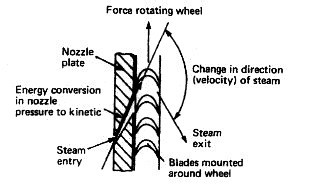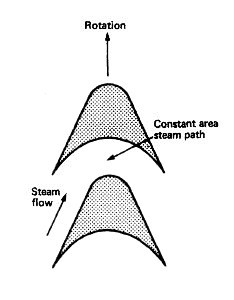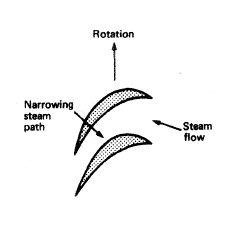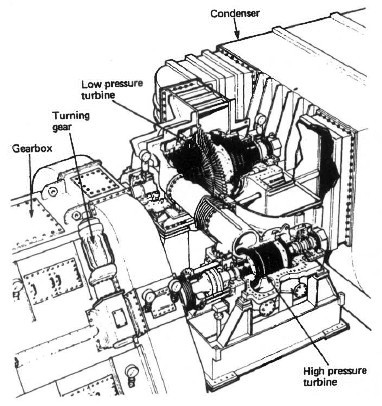Steam turbines
The steam turbine has until recently been the first choice for very large power marine propulsion units. Its advantages of little or no vibration, low weight, minimal space requirements and low maintenance costs are considerable. Furthermore a turbine can be provided for any power rating likely to be required for marine propulsion. However, the higher specific fuel consumption when compared with a diesel engine offsets these advantages, although refinements such as reheat have narrowed the gap.

Fig: Energy conversion in a steam turbine
The steam turbine is a device for obtaining mechanical work from the energy stored in steam. Steam enters the turbine with a high energy content and leaves after giving up most of it. The high-pressure steam from the boiler is expanded in nozzles to create a high-velocity jet of steam. The nozzle acts to convert heat energy in the steam into kinetic energy. This jet is directed into blades mounted on the periphery of a wheel or disc (Figure above).
The steam does not 'blow the wheel around'. The shaping of the blades causes a change in direction and hence velocity of the steam jet. Now a change in velocity for a given mass flow of steam will produce a force which acts to turn the turbine wheel, i.e. mass flow of steam (kg/s) x change in velocity (m/s) = force (kgm/s2).
This is the operating principle of all steam turbines, although the arrangements may vary considerably. The steam from the first set of blades then passes to another set of nozzles and then blades and so on along the rotor shaft until it is finally exhausted. Each set comprising nozzle and blades is called a stage.
Impulse steam turbine and reaction steam turbine - operating principle
Steam turbines

Fig: Energy conversion in a steam turbine
The steam turbine is a device for obtaining mechanical work from the energy stored in steam. There are two main types of turbine, the 'impulse' and the 'reaction'. The names refer to the type of force which acts on the blades to turn the turbine wheel.

Fig: Impulse blading
Impulse turbine
The impulse arrangement is made up of a ring of nozzles followed by a ring of blades. The high-pressure, high-energy steam is expanded in the nozzle to a lower-pressure, high-velocity jet of steam. This jet of steam is directed into the impulse blades and leaves in a different direction . The changing direction and therefore velocity produces an impulsive force which mainly acts in the direction of rotation of the turbine blades. There is only a very small end thrust on the turbine shaft.

Fig: Reaction blading
Reaction blading
The reaction arrangement is made up of a ring of fixed blades attached to the casing, and a row of similar blades mounted on the rotor, i.e. moving blades . The blades are mounted and shaped to produce a narrowing passage which, like a nozzle, increases the steam velocity. This increase in velocity over the blade produces a reaction force which has components in the direction of blade rotation and also along the turbine axis. There is also a change in velocity of the steam as a result of a change in direction and an impulsive force is also produced with this type of blading. The more correct term for this blade arrangement is 'impulse-reaction'.
Cross compound steam turbine arrangement
What is Compounding
Compounding is the splitting up, into two or more stages, of the steam pressure or velocity change through a turbine. Pressure compounding of an impulse turbine is the use of a number of stages of nozzle and blade to reduce progressively the steam pressure. This results in lower or more acceptable steam flow speeds and a better turbine efficiency.
Velocity compounding of an impulse turbine is the use of a single nozzle with an arrangement of several moving blades on a single disc. Between the moving blades are fitted guide blades which are connected to the turbine casing. This arrangement produces a short lightweight turbine with a poorer efficiency which would be acceptable in, for example, an astern turbine.
The two arrangements may be combined to give what is called 'pressure-velocity compounding'. The reaction turbine as a result of its blade arrangement changes the steam velocity in both fixed and moving blades with consequent gradual steam pressure reduction. Its basic arrangement therefore provides compounding.

Fig: Cross compound steam turbine arrangement
The term 'cross-compound' is used to describe a steam turbine unit made up of a high pressure and a low pressure turbine . This is the usual main propulsion turbine arrangement. The alternative is a single cylinder unit which would be usual for turbo-generator sets, although some have been fitted for main propulsion service.
Reheat
Reheating is a means of improving the thermal efficiency of the complete turbine plant. Steam, after expansion in the high-pressure turbine, is returned to the boiler to be reheated to the original superheat temperature. It is then returned to the turbine and further expanded through any remaining stages of the high-pressure turbine and then the low-pressure turbine.
No comments:
Post a Comment